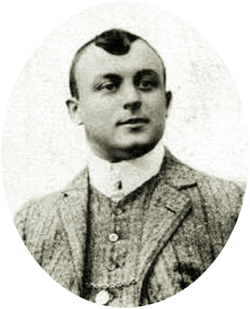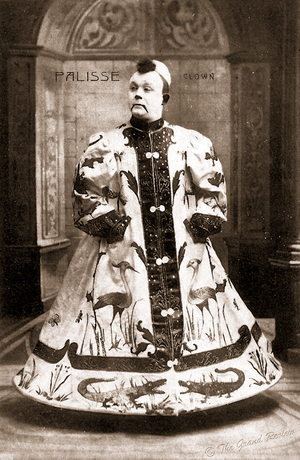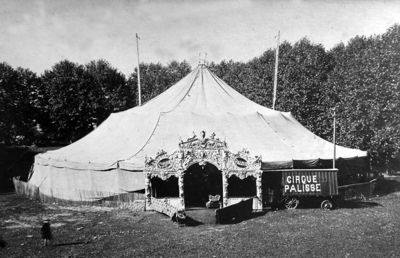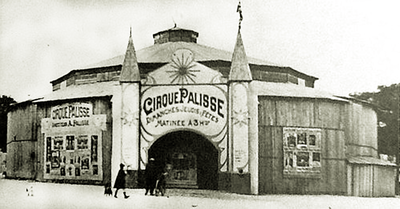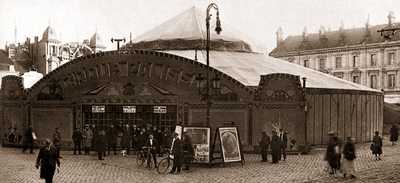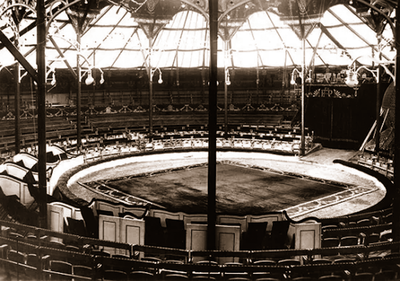Alexandre Palisse
From Circopedia
Clown, Circus Owner, Animal Trainer
By Dominique Jando
In the first half of the twentieth century, Alexandre Palisse (1876-1932) managed one of the best circuses touring the French provinces (and some bordering countries); in addition, his traveling equipment, which he conceived, was extremely innovative at the time and would inspire some of his competitors' way of touring. Palisse was also a clownGeneric term for all clowns and augustes. '''Specific:''' In Europe, the elegant, whiteface character who plays the role of the straight man to the Auguste in a clown team., well known in Europe and South America for his spectacular costumes, his impeccable makeup, and his talent for training small animals. After his death in 1932, Jérôme Medrano bought and continued to exploit his elegant and revolutionary touring circus.
The Clown Palisse
Alexandre François Palisse was born in a circus family on November 17, 1876, during a family stay in Saint-Chamond, an early industrial town in the Rhône-Alpes region of France. His father was Louis-Marius Palisse (1856-1891), an acrobat; his mother, Louise (1859-1895), née Bertoletti, was an equestrienneA female equestrian, or horse trainer, horse presenter, or acrobat on horseback.. Alexandre, who had a younger brother, Nicolas (1879-1938, an acrobat), was fifteen when he lost his father, and his mother died four years later: He had to help supporting his family at a young age, which developed in him earnestness and a sense of responsibility that was in no small part the reason of his success in life.He was a good acrobat and tumbler, and had a knack for training small domestic animals, notably dogs. This led him to clowning, since small animal training was at the time regarded as the domain of clowns (which was spectacularly demonstrated by many of them, notably Anatoly and Vladimir Durov). Palisse worked either alone or with partners such as Pierre Perié (who will also create his own, successful circus) and Leonardo Ceratto, with whom he worked extensively in Spain and Portugal, and even in Argentina, where he had an enormous success with his trademark trained bulldogs.
Around 1903-1904, Palisse was performing at the Cirque Plège, a popular French traveling circus of the period, which was showing at the annual fair of Amiens, in the north of France. Also at the fair was the Théâtre Grenier, a well-known traveling theater created by Ernest Grenier (1855-1920), which presented a mixture of short films (a great novelty then) and variety acts. Adrienne Grenier (1882-1959), the owner's daughter, fell in love with Palisse, whom she went and see perform every day after her own performance at the Théâtre Grenier. Palisse reciprocated her feelings, and they were married in Caen, Normandy, on April 9, 1904—just before the start of this port city's annual fair. Then, in the summer of 1906, Palisse was touring in South America with Adrienne when, on July 4 in Montevideo, Uruguay, she gave him a son whom they named after his maternal grandfather, Ernest.
Now that he was Ernest Grenier's son-in-law, Palisse became a regular fixture of the Théâtre Grenier's programs. Grenier liked Palisse as a clownGeneric term for all clowns and augustes. '''Specific:''' In Europe, the elegant, whiteface character who plays the role of the straight man to the Auguste in a clown team., but he also appreciated his seriousness; Palisse was helpful, hard-working, and a good addition to the family. The Théâtre Grenier was a successful business and, as an insider, Palisse had the opportunity to learn how to run efficiently a traveling entertainment organization; furthermore, not a simple employee anymore, he enjoyed his new status as member of a performing family that ran its own business, and he began entertaining the possibility of creating his own traveling circus. He eventually shared his aspirations with his father-in-law, who was willing to help finance his project.
The Cirque Palisse
Whenever they could, major French traveling circuses abandoned their tent to perform in municipal circus buildings, when available, or had a carpenter (either part of the company or local) erect a wooden circus on a set model, which was used for long engagements in important cities (notably during local fairs) and discarded afterwards. It was called a "construction(French) A temporary circus building, originally made of wood and canvas, and later, of steel elements supporting a canvas top and wooden wall. Also known as a "semi-construction."," and only a few elements (such as façade components, signage, etc.) traveled with the company. Sometimes, the local carpenter (or even the circus owner) kept the construction(French) A temporary circus building, originally made of wood and canvas, and later, of steel elements supporting a canvas top and wooden wall. Also known as a "semi-construction." so erected as long as it remained serviceable and rented it out to other visiting circuses.
Palisse knew from experience that, if one could put together a good show, the real money was in local fairs. Fairs were major annual events that lasted sometimes several weeks, during which locals and visitors expected to be entertained. For a circus such as Palisse's, long stays on a fairground meant less transportation and advertising expenses and, since the fairs happened each year at the same time, once you had secured return engagements, they allowed the development of a loyal local audience—if you delivered the goods, which Palisse did. Although his tent gave him the possibility to move often and even do one-day stands, it was not something that appealed to Palisse. He liked to present his shows in the best possible conditions, which indeed one- or two-day stands didn’t allow.When he visited fairs, Palisse discarded his tent and replaced it by a large and comfortable "construction(French) A temporary circus building, originally made of wood and canvas, and later, of steel elements supporting a canvas top and wooden wall. Also known as a "semi-construction."," built on the same plan wherever he went. But a big topThe circus tent. America: The main tent of a traveling circus, where the show is performed, as opposed to the other tops. (French, Russian: Chapiteau) had also its advantages. When the war was declared on July 28, 1914, between France and Germany, the German circus Wilhelm Hagenbeck, managed by Wilhelm’s sons, Willy and Carl, Jr., found itself marooned in Grenoble, on French territory, where it had been touring. The border between France and Germany being closed, the Hagenbecks couldn’t repatriate their circus and its large menagerie to their country, and Palisse came to the rescue: He made a deal with them and went to neutral Spain and Portugal, where he toured at the beginning of the hostilities with the Hagenbeck menagerie as an adjunct to his traveling circus—a move that proved quite lucrative for him, and also beneficial for the Hagenbecks. He resumed his French tours in 1916.
The war over, Palisse limited his territory to the north of France, Belgium, and Switzerland, presenting excellent shows with top-shelf acts; to maintain this quality, he Increasingly sought opportunities to work long stands under a "construction(French) A temporary circus building, originally made of wood and canvas, and later, of steel elements supporting a canvas top and wooden wall. Also known as a "semi-construction."," and he developed a circuit of French towns where he regularly returned each year. However, if the stand was not long enough, erecting a new construction(French) A temporary circus building, originally made of wood and canvas, and later, of steel elements supporting a canvas top and wooden wall. Also known as a "semi-construction." for the occasion could be time consuming, relatively expensive, and considering its temporary nature, it was sometimes a waste of time, money, and energy, not to mention a waste of construction(French) A temporary circus building, originally made of wood and canvas, and later, of steel elements supporting a canvas top and wooden wall. Also known as a "semi-construction." materials.
Palisse's Semi-Construction
Palisse's semi-construction(French) A temporary circus building, originally made of wood and canvas, and later, of steel elements supporting a canvas top and wooden wall. Also known as a "semi-construction." structure was made of a metallic framework that could be dismantled, with ten posts distributed around the ring supporting a metallic cupola frame. It was thirty-six meters in diameter and about thirteen meters to the top of the cupola; the structure was roofed with a heavy canvas cover and the peripheral walling was made of wooden panels. Inside, a wooden floor covered the entire ground, protecting the house from running rainwater and humidity and allowing to properly level the house and the ring. An extension running in the back of the structure's periphery housed stables and backstage area.
The seating system comported six elegant boxes facing the ring entrance and folding theater seats on the sides and behind the boxes. The second category of seats, in the back, were more conventional benches, and there was a promenoir (standing room) behind the last row of seats. The seating was supported by a traditional wooden framework, similar to those used under canvas, and the ring's floor was covered with a coco mat, as was the practice in the Parisian circuses—and the elegantly furbished house had indeed the feel of a bona fide circus building. The circus was said to accommodate 3,300 spectators, which was undoubtedly inflated: From the existing photographs, one may surmise that it contained about 1,800 seats, promenoir not included. With a sufficient workforce, the ensemble could be set up in two days; it took about six days with a limited crew of four.The semi-construction(French) A temporary circus building, originally made of wood and canvas, and later, of steel elements supporting a canvas top and wooden wall. Also known as a "semi-construction.", which traveled by rail, was inaugurated in November 1921 in Dunkerque (Dunkirk), where it was erected for the Foire d'hiver (winter fair). Alexandre and Adrienne Palisse had good reason to celebrate, but unfortunately their professional achievements were shadowed by a family tragedy: On December 21, 1920, Ernest, their son, had died in Orléans. Ernest was only fourteen, and was a promising performer—not to mention that he was the Palisses' only heir. To make matters worse, Adrienne's father, Ernest Grenier, had passed away that same year, on April 19, in Caen, where his Théâtre Électrique was performing at the annual fair. But, as they say, "the show must go on," and Alexandre Palisse, faithfully seconded by his wife, Adrienne, continued his successful tours, working either in local circus buildings or with the semi-construction(French) A temporary circus building, originally made of wood and canvas, and later, of steel elements supporting a canvas top and wooden wall. Also known as a "semi-construction.".
His shows, as usual, were of excellent quality. Offering good working conditions with long stands in a comfortable environment, he had no difficulty attracting the best acts in the business—from the famous liberty"Liberty act", "Horses at liberty": Unmounted horses presented from the center of the ring by an equestrian directing his charges with his voice, body movements, and signals from a ''chambrière'' (French), or long whip. acts of the Swedish director Henning Orlando and of the French Jules Glasner, to the famous Rainats on the flying trapezeAerial act in which an acrobat is propelled from a trapeze to a catcher, or to another trapeze. (See also: Short-distance Flying Trapeze), the Popescus, one of the greatest horizontal bars act in circus history, the great equestrian Roberto de Vasconcellos, and the lions and tigers of Martha La Corse, among many others. Palisse was a clownGeneric term for all clowns and augustes. '''Specific:''' In Europe, the elegant, whiteface character who plays the role of the straight man to the Auguste in a clown team., and not unexpectedly, some of the greatest clowns of the period graced his ring: After Foottit & Chocolat before WWI, Little Walter, Gontard, Despard-Plège, Manetti, Charley Meyer, Coco (Raoul Jouin) and the young Rhum, who was soon to become a major clowning star at Paris's Cirque Medrano, provided quality laughter.
Epilogue
In 1928, twenty-one years old Jérôme Medrano took over the management of his family's circus, Paris's legendary Cirque Medrano, steering it into a new era. That same year, he had married Rachel Baquet, whose father had worked in an administrative capacity for Alexandre Palisse. Baquet introduced Palisse to the young director: Jérôme Medrano was the same age his son would have been. Palisse took an immediate liking to Jérôme, to whom he became a mentor during Jérôme's early years at the helm of his Parisian circus.
For Jérôme Medrano, who had lost his father when he was just five years old, Palisse's affection and wisdom were a comforting feeling during his directorial formative years. Unfortunately, it didn't last long: Alexandre Palisse died suddenly, at age fifty-six, on March 27, 1932, in his Parisian home. He was buried at the Cimetière Parisien de Saint-Ouen, a Paris suburb. His widow, Adrienne, who had helped him manage his circus, took over, but the burden was too heavy for her. She sold the semi-construction(French) A temporary circus building, originally made of wood and canvas, and later, of steel elements supporting a canvas top and wooden wall. Also known as a "semi-construction." to Jérôme, whom her husband had considered like the son he had lost.
Jérôme Medrano launched his new itinerant circus under Palisse's semi-construction(French) A temporary circus building, originally made of wood and canvas, and later, of steel elements supporting a canvas top and wooden wall. Also known as a "semi-construction." in Le Havre on September 30, 1932, under the title Cirque Palisse-Medrano, to respect the contract Palisse had with that city, which ended in 1932. Thereafter, under the Cirque Medrano title, he kept touring Palisse's well-established circuit, and, until the end of 1937, presented high-quality shows that Alexandre Palisse would have certainly approved. (Adrienne Palisse passed away in 1959.)
Suggested Reading
- Adrian, Sur les Chemins des Grands Cirque Voyageurs (Bourg-la-Reine, published by the author, 1959)
